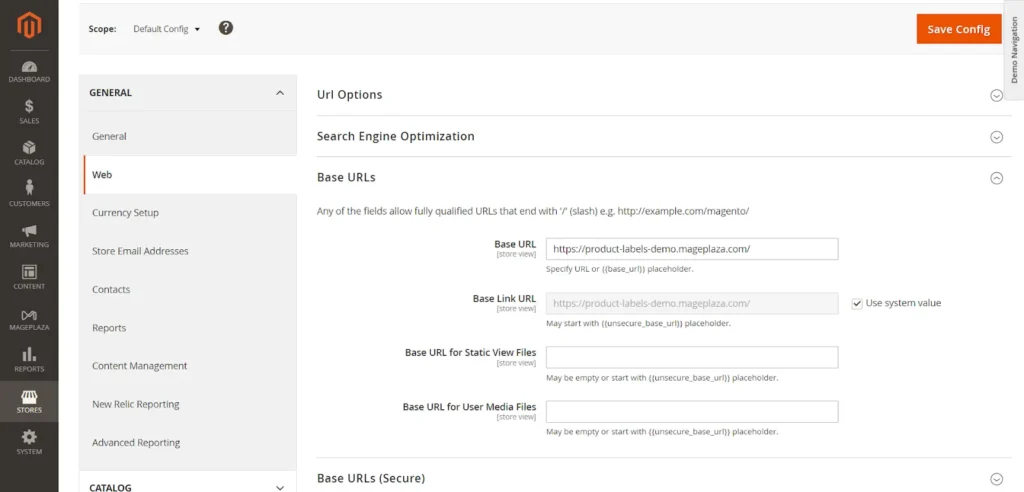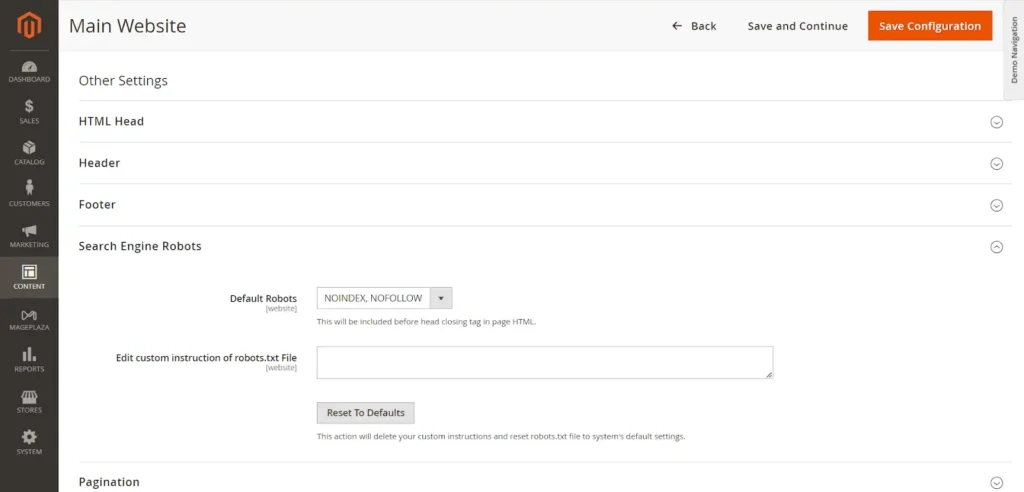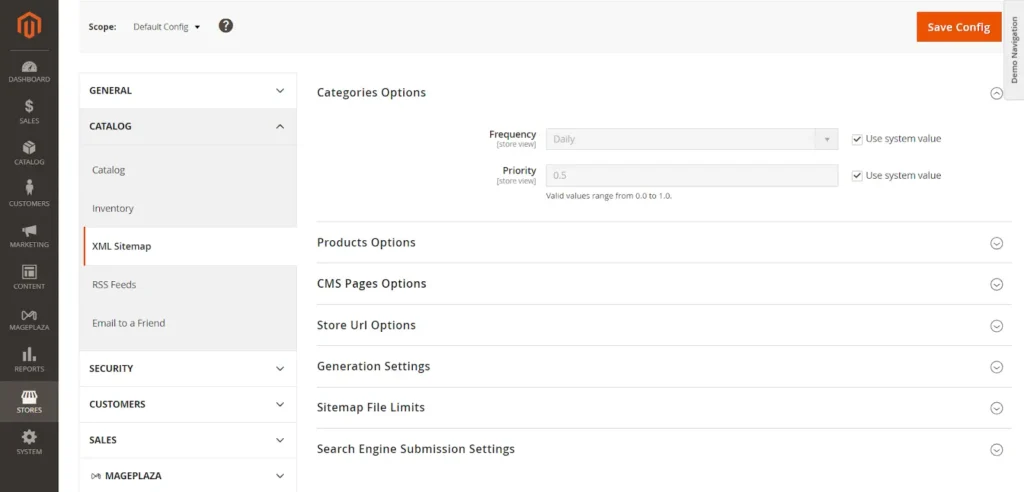Are you tired of PPC costing you arm and leg but failing to provide you with steady traffic to the store? As competition intensifies, especially in eCommerce, you need a reliable strategy to stay on top of search results. That is the main goal of search engine optimization.
Magento SEO plays a vital role if you want to secure your place in the eCommerce marketplace. Why? By optimizing the website for search engines, you ensure a stable flow of organic visitors. Organic means not generated by paid ads. So, the business becomes more viable, and its place in search results doesn’t depend on whether you pay for ads or not.
Now let’s make it clear: What does a Magento store owner need to do on its website SEO-wise? Magento is a robust eCommerce platform with a user-friendly interface, powerful performance, and scalability opportunities. As Magento 2 has replaced M1, it has also got improved SEO features. And your task is to use them right. Because if you don’t harness all the potential of this platform, you definitely leave a fortune on the table.
In this Magento SEO guide, we’ll dwell on Magento 2 SEO, including on-page, off-page, and technical SEO. I’ll also overview some Magento 2 SEO extensions to go beyond the built-in Magento capabilities.
What Is Magento SEO, and What SEO Features Does It Offer?
Magento SEO covers various strategies to achieve better search results. It’s needed to attract traffic to the website, which will then convert into customers (if the store is optimized for conversions). The higher the website is on the search engine results page (SERP), the more people will see it. The more viewers you’ll ensure, the more clicks in the store you’ll have. Clicks then turn into orders and, ultimately, revenue. That’s simple.
Plus, SEO is tightly connected to user experience. Whether you add the best-suited keywords or increase the website speed, you make the store not only more SEO-optimized but user-friendly as well. So, you make it more convenient for visitors to navigate, which brings conversions.
Compared to other eCommerce platforms, Magento 2 offers more advanced and customizable SEO settings. Among its integrated features are:
- Custom URL structures (to create SEO-friendly link addresses);
- Meta information management (meta titles, descriptions, and keywords);
- Sitemap generation capabilities (to allow search engines to easily crawl and index the website).
You may access these tools in the Magento backend and tweak the settings yourself. However, addressing a Magento 2 development company will speed up the process and ensure nothing gets overlooked.
In the next sections, we’ll explore how to optimize a Magento 2 store, configure common SEO settings, and develop a promotional strategy that aligns with your business goals. Let’s proceed:
Optimizing the Store: How to Do SEO on Magento
On-Page Magento 2 SEO Best Practices
Magento on-page SEO covers strategies for optimizing the webpages and their content to make them user- and SEO-friendly, such as:
- Crafting compelling product titles and descriptions
- Producing high-quality content (including a blog)
Titles and descriptions are the meta information that drives traffic to the store. They appear on search engines and should encourage people to click. It’s a small piece of information that should be concise and engaging. For example, the user should understand that they’ll proceed to the page relevant to their request.
That’s where keywords inserted into metadata may help. However, don’t force them into the meta-information. Strike a balance between creating descriptive text and keyword stuffing. The same rules apply to product descriptions, which should be easy to read, informative and naturally contain keywords. Focus on solving your consumers’ problems, not just selling them stuff.
But not only your product descriptions should provide high-quality content. Deliver helpful information across the website, especially if you have a blog. An eCommerce blog gives you the ability to cover topics related to products in more detail, share the expertise, and answer common customer questions.
There, you may include keywords to attract the target audience, establish the brand as a thought leader, and talk about the products once more. It would definitely give you a sales boost.
Technical Magento SEO Checklist
Technical SEO denotes works on the website and server, such as:
- Configuring page components;
- HTTP header responses;
- XML sitemaps;
- Redirects;
- Metadata, etc.
Consider these Magento SEO tips on enhancing the technical aspects of the store:
- Optimize site speed: Search engines, especially Google, give preference to fast-loading sites when deciding on their positions. How do you speed up the store? Reduce image size, enable caching, and minimize the use of heavy JavaScript and CSS files.
- Think of your mobile version: Making your Magento 2 store mobile-friendly involves more than just shrinking the site to fit on a smaller screen—it also entails making sure that the user experience is seamless and straightforward. So, texts should be accessible without the need to zoom in, the room for touch targets should be sufficient, and mobile pages should load quickly. Talking about loading speed, the mobile site’s performance plays a vital role in determining your search engine rankings because of Google’s mobile-first indexing.
- Use HTTPS for secure browsing: For Magento, using an HTTPS (SSL) certificate is the best option to protect and store customer data. It signals that the data exchanged between the website and visitors is encrypted. So, no suspicious third party can steal sensitive details.
Safeguarding such information is one of the most straightforward and essential things an eCommerce store can do to gain customers’ trust.
Here is how you can enable HTTPS in Magento:
- Navigate to “Stores” > “Configuration” (under “Settings”) > “General” > “Web” to adjust the settings.
- Expand “Base URLs (Secure)” and modify “Secure Base URL” and “Secure Base Link URL” to begin with “https” there.

Screenshot taken on the official Mageplaza website
Additionally, set the value of the “Enable HTTP Strict Transport Security (HSTS)”, “Upgrade Insecure Requests”, “Use Secure URLs in Admin”, and “Use Secure URLs on Storefront” boxes to “Yes”.

Screenshot taken on the official Mageplaza website
Site Architecture: Magento SEO Best Practices
Site architecture describes the organization of a website. It improves the user experience, helping shoppers get from one page to another and complete the order. As UX impacts Google rankings, the better you organize the structure, the higher the store will appear.
It also improves site crawlability and, eventually, rankings, assisting search engines in analyzing the website. It gives a clear picture of your Magento store–how its pages and content are organized and interlinked. With a well-planned site architecture, you can guide search engines to the most important pages. For users, a decent structure means less confusion and frustration.
Magento offers robust options for categorizing and displaying products. A typical Magento store might have a structure that includes a homepage, category pages, product pages, informational pages (like ‘About Us’ or ‘Contact’), and a blog. Your site architecture is how you organize, link, and present these sections. To prepare it, follow these steps:
- Define understandable, logical categories.
- Narrow down by creating subcategories.
- Optimize navigation menus to reflect your categories and subcategories in an accessible and concise manner.
- Implement breadcrumbs to show the path consumers have made before landing on the current page.
- Customize URLs to make sure they are clean, user-friendly, and keyword-rich.
- Create a logical internal linking structure by connecting related products and content.
- Utilize Magento’s capabilities, such as the ability to create custom product attributes.
Configure the robots.txt File
Another technical SEO tip revolves around creating a robots.txt file in Magento. It instructs search engine bots on which parts of the site they should and shouldn’t crawl.
In what cases may you want to limit access to certain parts of the site? For example, login and internal search pages typically don’t contain content relevant to external users. Faceted navigation, another type of pages to block from crawling, may bring duplicate content issues. Due to this, it’s better to limit access to these pages.
Magento provides an easy way to tweak the robots.txt file directly from the admin panel. Here is how:
- Log into the Magento admin panel. Navigate to “Content”, then under the “Design” section, select “Configuration”.
- Once you’re in the “Configuration” menu, head over to the “Website” for which you’re planning to modify the file.
- Click “Edit”, scroll down to “Search Engine Robots”, and choose the desired option in the “Default Robots” menu.
- Do you see the “Edit custom instruction of the robot.txt File” section? This is where you can make changes to the robots.txt file. It’s a straightforward text box where you can input directives.

Screenshot taken on the official Mageplaza website
The robots.txt file allows you to set up various guidelines. Here are a few pointers:
- The simplest directives are Disallow and Allow. To prevent search engines from indexing a customer login page, use Disallow: /customer/account/login/.
- Block pages that don’t offer unique value (like certain search result pages) by adding lines like Disallow: /catalogsearch/.
- Specify the main version using canonical tags for products and categories with multiple URLs.
Note: Be cautious not to block pages vital for your SEO. Sometimes, in an attempt to clean up, store owners accidentally block important pages.
Save changes (find the “Save Config” button for this purpose) after editing the file. Plus, regularly review and adjust it, especially if you make significant changes to your site’s structure or content.
Why Are XML and HTML Sitemaps Important?
Due to its versatility and scalability, Magento typically hosts mid- and large-sized online stores with numerous pages and products. As a result, the structure of such eCommerce websites may get too complex. It may prevent search engines from crawling all of them properly or lead to content duplication.
That’s where XML and HTML sitemaps come into play. The former is directed at robots, and the latter serves to simplify the user experience for shoppers. Both are crucial for SEO, as search engines favor stores having a quick and well-defined path to all the pages. Here’s why:
- It ensures efficient crawling thanks to a clear site structure.
- A good website structure enables search engines to present your pages correctly in search results.
- Search engines can more efficiently index the website, retrieving information faster in response to user queries.
- It becomes easier to determine whether the content is relevant to user queries, which can lead to better performance in search engines.
An XML sitemap lists all the critical URLs within your site, including new products that may be frequently added to the store. It represents the structure of the Magento site. It’s like directing robots to new and updated content.
To implement the sitemap in Magento:
- Navigate to “Marketing” > “SEO & Search” > “Site Map”.
- Click on “Add Sitemap” and provide the necessary details, such as the sitemap’s filename and path.
- Save and generate the sitemap.
The XML sitemap configuration looks like this:
- Go to “Stores” > “Configuration” > “Catalog” > “XML Sitemap”.
- Adjust various settings:
- The frequency of sitemap generation (daily, weekly, etc.);
- The number of links per sitemap;
- The maximum file size.
- You can also enable the submission of your sitemap to robots.txt so that search engines could easily find and crawl it.

Screenshot taken on the official Mageplaza website
HTML sitemaps differ from XML sitemaps as they are designed for users. They also provide a navigable list of pages on the site, making it easier for visitors to find what they need. Although HTML sitemaps are more user-oriented, they also assist search engines in understanding and crawling the website’s structure.
Unfortunately, Magento 2 doesn’t auto-generate HTML sitemaps. But you can remedy this flaw by installing third-party SEO plugins. Choose the desired one and follow its guidelines to create and maintain an HTML sitemap. Keep in mind the following pieces of Magento SEO advice:
- Update the sitemaps to reflect the latest content—what you added, removed, and updated.
- Prioritize unique and distinct pages to avoid duplication.
- Conduct a Magento SEO audit with tools like Screaming Frog or SEMrush to check the sitemap health and identify duplicate content.
Advanced Magento SEO Optimization Strategies
Utilizing Magento SEO Extensions
Magento boasts seamless compatibility with numerous extensions and services, so you may get SEO solutions to boost the store’s performance in SERPs. These tools can streamline complex SEO tasks, automate processes, and provide robust analytics. Whether it’s improving the site’s navigation, optimizing metadata, or managing sitemaps, there’s likely an extension to help.
Some popular Magento SEO extensions include:
- Magento 2 SEO Extension by BSS. It provides rich snippets functionality, HTML sitemap generation, and breadcrumbs optimization. As a result, it improves visibility and click-through rates, reduces bounce rates, and enhances the overall user experience.
- Magento 2 SEO Extension by Mageplaza. This add-on prevents duplicate content issues, simplifies the process of adding structured Schema to your online store, and creates SEO reports. You may spot missing metadata or 404 error pages to add the needed information or remove broken links for better performance.
- Magento 2 SEO Extension by FME Extensions. Here, you may explore advanced meta templates, implement canonical tags, and interlink product pages with ease. The extension improves the site’s relevance, searchability, navigation, and SEO.
- SEO Toolkit by Amasty. This module assesses the SEO health of your pages in just one click. It helps manage redirects and pagination to prevent issues like duplicate content and broken pages. It supports the development of unique meta descriptions and templates for pages and categories through Yoast integration.
- SEO Suite Ultimate by Mageworx. Set up various types of redirects and optimize a large volume of data to achieve better rankings. Use the advanced rich snippet feature, employ hreflang tags, and localize content to tap into global Magento 2 SEO.
- Advanced SEO Suite by Mirasvit. The tool automatically fills metadata across the site, manages 301, 302, or 307 redirects efficiently, and offers a built-in crawler, providing recommendations for improvement. The result? Skyrocketed click-through rates from search results and maintained the site’s SEO value during changes.
Exploring Magento 2’s Rich Snippets and Structured Data
Structured data refers to the data organized in such a way that search engine crawlers can easily understand what your page is about. One of the forms of structured data is Schema markup. It’s a piece of code added to the website’s HTML.
Online store owners use it to improve the way search engines read and represent the page in SERPs. The goal? To provide more information about the product for users to learn about it right from search, for example:
- ratings;
- prices;
- availability.
It’s what we call rich snippets. Such results stand out from the rest, catch more attention, and boost click-through rates. Why are they so effective? First of all, their visual elements naturally draw the user’s eye, making these results more noticeable and, therefore, more likely to be clicked on.
They allow people to decide whether to click on your link or not without visiting the store. On the one hand, it may reduce the number of visitors as someone may click on the competitors’ link. On the other hand, rich snippets lessen the likelihood of visits from consumers who aren’t actually interested in what the page offers. This leads to more qualified traffic and potentially better engagement on the site.
Rich snippets also serve as a significant differentiator in the competitive eCommerce market. They can make your products or content appear more appealing than competitors with only standard listings in search results.
Structured data can contribute to better search rankings. While not a Google ranking factor, it facilitates page indexing and offers more precise and focused metadata. It communicates with the search engine in a standardized format, the language that Google and the like can comprehend.
You may find it hard to create a Schema markup in Magento. Using a Magento 2 SEO extension such as Magefan’s “Magento 2 Rich Snippets Extension” is the easiest way to do it. It automates the process and guarantees accurate Schema.org markup for product pages. You may opt for manual implementation for more control, but you’ll need experts in editing the PHP files.
SEO for Magento eCommerce: Top Tips for Managing Rich Snippets
Promote the most expensive products by giving them the spotlight with rich snippets.
Measure the rich results performance and how the structured data is parsed and presented with tools like Google Rich Results Test.
If there are any changes to the product details, particularly the price and availability, update the structured data to avoid misalignment and frustration.
Off-Page SEO and Link Building
At last, let’s talk about the Magento 2 SEO tips regarding off-page optimization. These are strategies implemented outside your website to boost its visibility and attract traffic. For example, they include:
- Earning backlinks from other websites;
- Leveraging social media;
- Building brand awareness.
Developing a Robust Backlink Strategy
Backlinking is the main off-page Magento 2 SEO optimization technique. Links from other websites (provided you’ve got them legally and didn’t buy them on third-party websites) serve as a referral from their owners. It’s like saying, “This website is trustworthy, so we link to it and offer our visitors to explore it too.”
Keep in mind that earning backlinks may turn into grey hat SEO if you’ve gained them not organically but through manipulative tactics:
- Excessive link exchanges;
- Using private blog networks;
- Subtly paying for links under the guise of sponsorships or collaborations.
However, if done correctly, backlinking can significantly boost the store rankings. Just follow these best SEO for Magento 2 tips to be on the safe side:
- Backlinks should come from reputable websites relevant to your niche. That’s where quality beats quantity.
- Create share-worthy content (top-notch blog posts, infographics, or product videos).
- Write for other industry blogs or platforms to provide them with quality content and, in return, get a backlink.
- Partner with influencers or other businesses for joint marketing campaigns to naturally generate backlinks.
Social Media and Its Impact on SEO
Social media might not directly influence search rankings, but it certainly plays a supporting role in Magento SEO:
- Active social media profiles can drive traffic to the Magento store. It means more visibility and positive signals to Google to rank the website better.
- There, you may share content and information about products others may want to distribute too and link back to you.
- Social signals, such as shares and likes, can positively impact your site’s credibility and authority. But still, don’t count on them much.
Building Brand Awareness Through SEO
Brand awareness, in simple terms, is the popularity of your brand among the target audience. Brands with high awareness are often referred to as “trending,” “buzzworthy,” or simply “popular.” It means customers may easily recognize them and associate them with certain qualities, emotions, products, or services.
You should improve brand awareness because it leads to more branded searches on Google. For instance, these are searches like “Nike running shoes” or “Adobe Photoshop”. They include a particular company name. They are a positive signal to search engines as they testify to the interest in the store.
Strategies for enhancing brand awareness:
- Be consistent across all platforms—the website, social media, guest posts, etc.
- Communicate with the audience through social media, forums, and other platforms.
- Partner with influencers, launch PR campaigns, and provide exceptional customer service.
- Include branded keywords apart from generic ones.
Wrapping Up
As we bring this Magento 2 SEO guide to a close, let’s ponder a crucial question: Is Magento SEO-friendly? Of course, it is! Throughout this guide, we’ve seen how Magento’s features align perfectly with the best practices of Magento SEO marketing. We’ve sailed through the essentials of Magento SEO:
- Using Magento’s built-in SEO capabilities;
- Fine-tuning on-page elements;
- Mastering the technical intricacies;
- Creating XML and HTML sitemaps, and more.
Magento proves time and again that it’s built with SEO in mind. It’s adaptable, robust, and easy to connect with advanced SEO tools and strategies.
Couple that with your commitment to off-page SEO tactics like backlinking and social media engagement, and you’ve got a recipe for SEO success. So, when you ask, “Is Magento good for SEO?” the answer is a resounding “Yes!”
About the Author

Diana Kostogladova is an SEO expert at Onilab. With over 12 years of experience, she specializes in digital marketing, website optimization, and eCommerce. She adopts a holistic approach in her work and conducts deep research into SEO, personalization, SMM, and other topics before sharing her expertise with a wide audience.









